brake fluid YAMAHA YZF-R1 2019 Owners Manual
[x] Cancel search | Manufacturer: YAMAHA, Model Year: 2019, Model line: YZF-R1, Model: YAMAHA YZF-R1 2019Pages: 124, PDF Size: 9.58 MB
Page 6 of 124

Table of contentsSafety information........................... 1-1
Description ....................................... 2-1
Left view ......................................... 2-1
Right view ....................................... 2-2
Controls and instruments................ 2-3
Special features ............................... 3-1
YRC (Yamaha Ride Control) .......... 3-1
Glossary ......................................... 3-4
YRC functions visual guide............. 3-5
Instrument and co ntrol functions... 4-1
Immobilizer system ..... .................... 4-1
Main switch/steering lock................ 4-2
Handlebar switches ........................ 4-3
Indicator lights and warning lights ............................................ 4-5
Display ............................................ 4-8
MENU screen ............................... 4-13
Clutch lever................................... 4-26
Shift pedal..... ............................ .... 4-27
Brake lever ................................... 4-27
Brake pedal .................................. 4-28
Brake system ..... ....................... .... 4-28
Fuel tank cap ................................ 4-30
Fuel............................................... 4-31
Fuel tank overflow hose................ 4-32
Catalytic converter ........................ 4-33
Seats ............................................ 4-34
Document storage ........................ 4-35 Rear view mirrors ......................... 4-36
Adjusting the front fork ................. 4-36
Adjusting the shock absorber
assembly................................... 4-38
EXUP system ............................... 4-40
Auxiliary DC connector................. 4-41
Sidestand ..................................... 4-41
Ignition circuit cut- off system ........ 4-42
For your safety – pre-operation
checks .............................................. 5-1
Operation and important riding
points ................................................ 6-1
Starting the engine ......................... 6-1
Shifting ........................................... 6-2
Tips for reducing fuel consumption ............................... 6-3
Engine break-in .............................. 6-3
Parking ........................................... 6-4
Periodic maintenance and
adjustment ....................................... 7-1
Tool kit............................................ 7-2
Periodic maintenance charts .......... 7-3
Periodic maintenance chart for the emission control system ............. 7-3
General maintenance and
lubrication chart .......................... 7-5
Removing and installing cowlings and panels ............... ................... 7-9 Checking the spark plugs ............ 7-11
Canister ....................................... 7-12
Engine oil and oil filt
er cartridge... 7-12
Why Yamalube ............................ 7-16
Coolant ........................................ 7-16
Air filter element ........................... 7-17
Checking the engine idling speed............ ............................ 7-18
Checking the throttle grip free play ........................................... 7-18
Valve clearance ........................... 7-18
Tires ............................................. 7-19
Cast magnesium wheels.............. 7-21
Adjusting the clutch lever free
play ........................................... 7-22
Checking the brake lever free play ........................................... 7-23
Brake light switches ..................... 7-23
Checking the front and rear brake pads................................ 7-24
Checking the brake fluid level ...... 7-24
Changing the brake fluid .............. 7-25
Drive chain slack.......................... 7-26
Cleaning and lubricating the drive chain ................................ 7-27
Checking and lubricating the cables ....................................... 7-28
Checking and lubricating the
throttle grip and cable ............... 7-28
Checking and lubricating the brake and shift pedals .............. 7-28BX4-9-E2.book 1 ページ 2018年9月6日 木曜日 午後4時39分
Page 14 of 124

Description
2-2
12
3
4
5
6
7
8
9
10
11
12
EAU10421
Right view
4
3
567
2
1
8,9,10
1. Battery (page 7-32)
2. Front brake fluid reservoir (page 7-24)
3. Document storage space (page 4-35)
4. Coolant reservoir cap (page 7-16)
5. Engine oil filler cap (page 7-12)
6. Brake pedal (page 4-28)
7. Rear brake fluid reservoir (page 7-24)
8. Fast compression damping force adjuster (page 4-36) 9. Slow compression dampi
ng force adjuster (page 4-38)
10.Rebound damping forc e adjuster (page 4-38)
BX4-9-E2.book 2 ページ 2018年9月6日 木曜日 午後4時39分
Page 15 of 124
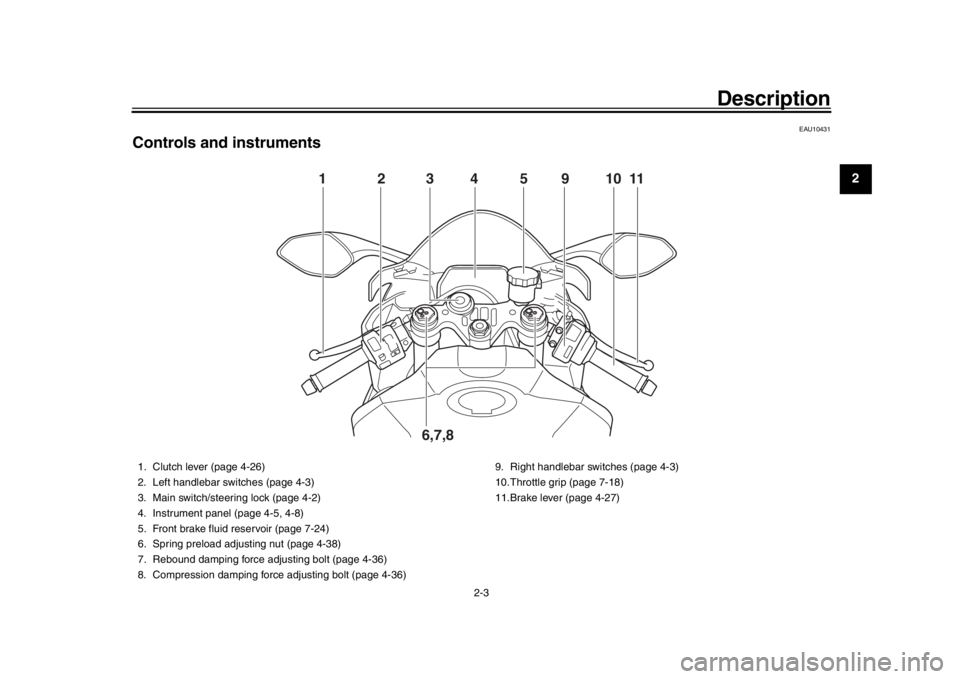
Description
2-3
123
4
5
6
7
8
9
10
11
12
EAU10431
Controls and instruments
1234 9 51011
6,7,8
1. Clutch lever (page 4-26)
2. Left handlebar switches (page 4-3)
3. Main switch/steering lock (page 4-2)
4. Instrument panel (page 4-5, 4-8)
5. Front brake fluid reservoir (page 7-24)
6. Spring preload adjusting nut (page 4-38)
7. Rebound damping force adjusting bolt (page 4-36)
8. Compression damping force adjusting bolt (page 4-36) 9. Right handlebar switches (page 4-3)
10.Throttle grip (page 7-18)
11.Brake lever (page 4-27)
BX4-9-E2.book 3 ページ 2018年9月6日 木曜日 午後4時39分
Page 64 of 124

5-1
1
2
3
45
6
7
8
9
10
11
12
For your safety – pre-operation checks
EAU15599
Inspect your vehicle each time you use it to make sure the vehi cle is in safe operating condition. Always follow the inspection
and maintenance procedures and schedules described in the Owner’s Manual.
WARNING
EWA11152
Failure to inspect or maintain the vehicle properly increases the possibility of an accident or equipment damage.
Do not operate the vehicle if you find any problem. If a problem cannot be corrected by the procedures provided inthis manual, have the vehicle inspected by a Yamaha dealer.
Before using this vehicle, check the following points:
ITEM CHECKS PAGE
Fuel Check fuel level in fuel tank.
Refuel if necessary.
Check fuel line for leakage.
Check fuel tank breather hose and overflow hose for obstructions, cracks or
damage, and check hose connections. 4-31, 4-32
Engine oil Check oil level in engine.
If necessary, add recommended oil to specified level.
Check vehicle for oil leakage. 7-12
Coolant Check coolant level in reservoir.
If necessary, add recommended coolant to specified level.
Check cooling system for leakage. 7-16
Front brake Check operation.
If soft or spongy, have Yamaha dealer bleed hydraulic system.
Check brake pads for wear.
Replace if necessary.
Check fluid level in reservoir.
If necessary, add specified brake fluid to specified level.
Check hydraulic system for leakage. 7-24
BX4-9-E2.book 1 ページ 2018年9月6日 木曜日 午後4時39分
Page 65 of 124

For your safety – pre-operation checks
5-2
1
2
3
456
7
8
9
10
11
12
Rear brake Check operation.
If soft or spongy, have Yamaha dealer bleed hydraulic system.
Check brake pads for wear.
Replace if necessary.
Check fluid level in reservoir.
If necessary, add specified brake fluid to specified level.
Check hydraulic system for leakage. 7-24
Clutch Check operation.
Lubricate cable if necessary.
Check lever free play.
Adjust if necessary. 7-22
Throttle grip Make sure that operation is smooth.
Check throttle grip free play.
If necessary, have Yamaha dealer adjust th
rottle grip free play and lubricate cable
and grip housing. 7-18, 7-28
Control cables Make sure that operation is smooth.
Lubricate if necessary. 7-28
Drive chain Check chain slack.
Adjust if necessary.
Check chain condition.
Lubricate if necessary. 7-26, 7-27
Wheels and tires Check for damage.
Check tire condition and tread depth.
Check air pressure.
Correct if necessary. 7-19, 7-21
Brake and shift pedals Make sure that operation is smooth.
Lubricate pedal pivoting points if necessary. 7-28
Brake and clutch levers Make sure that operation is smooth.
Lubricate lever pivoting points if necessary. 7-29
Sidestand Make sure that operation is smooth.
Lubricate pivot if necessary. 7-30
Chassis fasteners Make sure that all nuts, bolts and screws are properly tightened.
Tighten if necessary. —
ITEM CHECKS PAGE
BX4-9-E2.book 2 ページ 2018年9月6日 木曜日 午後4時39分
Page 75 of 124

Periodic maintenance and adjustment
7-5
1
2
3
4
5
678
9
10
11
12
EAU71352
General maintenance an d lubrication chartNO. ITEM CHECK OR MAINTENANCE JOB ODOMETER READING
ANNUAL
CHECK
1000 km
(600 mi) 10000 km
(6000 mi) 20000 km
(12000 mi) 30000 km
(18000 mi) 40000 km
(24000 mi)
1 *Diagnostic system
check Perform dynamic inspection using
Yamaha diagnostic tool.
Check the error codes.
2 *Air filter element Replace. Every 40000 km (24000 mi)
3Clutch Check operation.
Adjust.
4 *Front brake Check operation, fluid level, and
for fluid leakage.
Replace brake pads if necessary.
5 *Rear brake Check operation, fluid level, and
for fluid leakage.
Replace brake pads if necessary.
6 *Brake hoses Check for cracks or damage.
Replace. Every 4 years
7 *Brake fluid Change. Every 2 years
8 *Wheels Check runout and for damage.
Replace if necessary.
9 *Tires Check tread depth and for
damage.
Replace if necessary.
Check air pressure.
Correct if necessary.
10 *Wheel bearings Check bearing for looseness or
damage.
11 *Swingarm pivot
bearings Check operation and for
excessive play.
Lubricate with lithium-soap-based grease. Every 50000 km (30000 mi)
BX4-9-E2.book 5 ページ 2018年9月6日 木曜日 午後4時39分
Page 78 of 124
Periodic maintenance and adjustment
7-8
1
2
3
4
5
67
8
9
10
11
12
EAU72811
TIP
Air filter
This model’s air filter uses a disposable oil-coated paper element. This el ement cannot be cleaned with compressed
air, doing so will only damage it.
The air filter element needs to be replaced more fr equently when riding in unusually wet or dusty areas.
Hydraulic brake service
Regularly check the front and rear brake fluid levels. Replenish if necessary.
Every two years replace the rear brake master cylinder, the internal components of the front brake master cylinder, the brake calipers, and change the brake fluid.
Replace the brake hoses every four years or sooner if cracked, damaged, or if any section of the stainless steel brakehose has turned black.
BX4-9-E2.book 8 ページ 2018年9月6日 木曜日 午後4時39分
Page 94 of 124
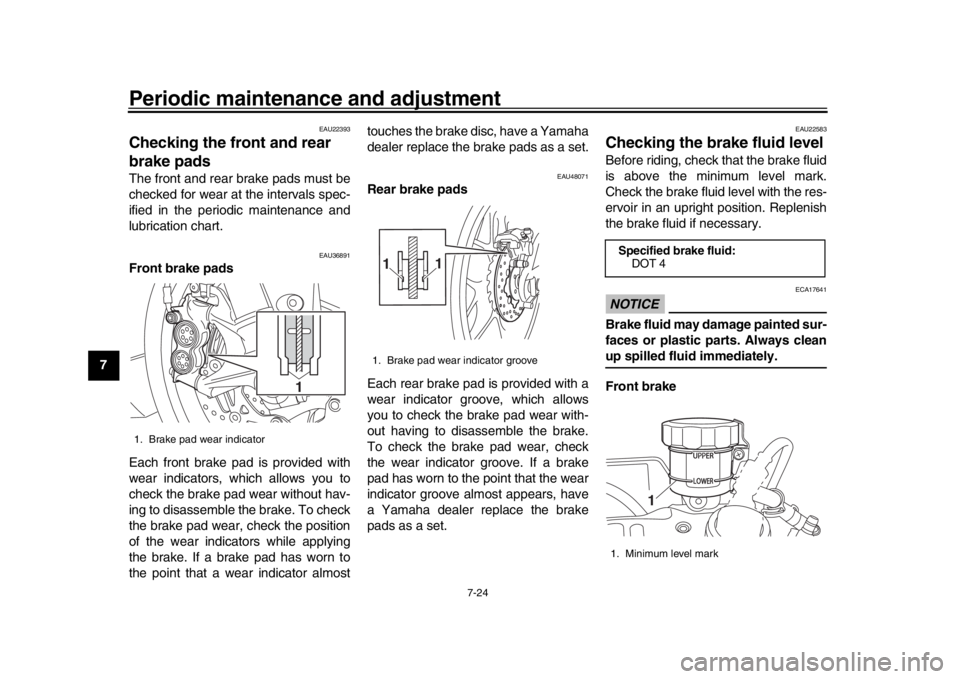
Periodic maintenance and adjustment
7-24
1
2
3
4
5
67
8
9
10
11
12
EAU22393
Checking the front and rear
brake padsThe front and rear brake pads must be
checked for wear at the intervals spec-
ified in the periodic maintenance and
lubrication chart.
EAU36891
Front brake pads
Each front brake pad is provided with
wear indicators, which allows you to
check the brake pad wear without hav-
ing to disassemble the brake. To check
the brake pad wear, check the position
of the wear indicators while applying
the brake. If a brake pad has worn to
the point that a wear indicator almost touches the brake disc, have a Yamaha
dealer replace the brake pads as a set.
EAU48071
Rear brake pads
Each rear brake pad is provided with a
wear indicator groove, which allows
you to check the brake pad wear with-
out having to disassemble the brake.
To check the brake pad wear, check
the wear indicator groove. If a brake
pad has worn to the point that the wear
indicator groove almost appears, have
a Yamaha dealer replace the brake
pads as a set.
EAU22583
Checking the brake fluid levelBefore riding, check that the brake fluid
is above the minimum level mark.
Check the brake fluid level with the res-
ervoir in an upright position. Replenish
the brake fluid if necessary.NOTICE
ECA17641
Brake fluid may damage painted sur-
faces or plastic parts. Always cleanup spilled fluid immediately.
Front brake
1. Brake pad wear indicator
1
1. Brake pad wear indicator groove
1
1
Specified brake fluid:
DOT 41. Minimum level mark
1
BX4-9-E2.book 24 ページ 2018年9月6日 木曜日 午後4時39分
Page 95 of 124
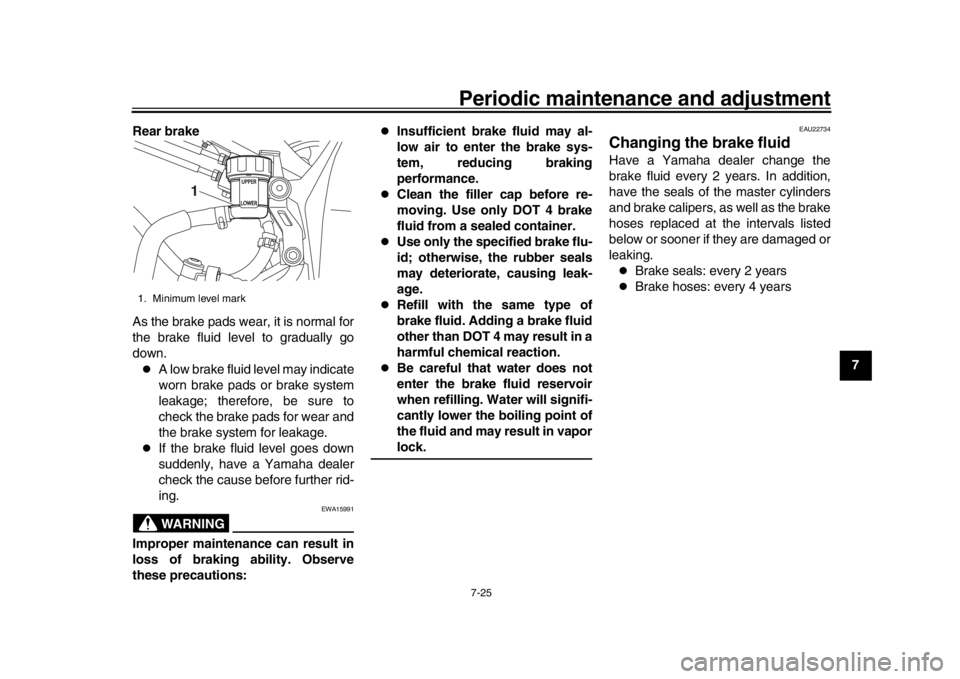
Periodic maintenance and adjustment7-25
1
2
3
4
5
678
9
10
11
12
Rear brake
As the brake pads wear, it is normal for
the brake fluid level to gradually go
down.
A low brake fluid level may indicate
worn brake pads or brake system
leakage; therefore, be sure to
check the brake pads for wear and
the brake system for leakage.
If the brake fluid level goes down
suddenly, have a Yamaha dealer
check the cause before further rid-
ing.WARNING
EWA15991
Improper maintenance can result in
loss of braking ability. Observe
these precautions:
Insufficient brake fluid may al-
low air to enter the brake sys-
tem, reducing braking
performance.
Clean the filler cap before re-
moving. Use only DOT 4 brake
fluid from a sealed container.
Use only the specified brake flu-
id; otherwise, the rubber seals
may deteriorate, causing leak-
age.
Refill with the same type of
brake fluid. Adding a brake fluid
other than DOT 4 may result in a
harmful chemical reaction.
Be careful that water does not
enter the brake fluid reservoir
when refilling. Water will signifi-
cantly lower the boiling point of
the fluid and may result in vaporlock.
EAU22734
Changing the brake fluidHave a Yamaha dealer change the
brake fluid every 2 years. In addition,
have the seals of the master cylinders
and brake calipers, as well as the brake
hoses replaced at the intervals listed
below or sooner if they are damaged or
leaking.
Brake seals: every 2 years
Brake hoses: every 4 years
1. Minimum level mark
1
BX4-9-E2.book 25 ページ 2018年9月6日 木曜日 午後4時39分
Page 111 of 124
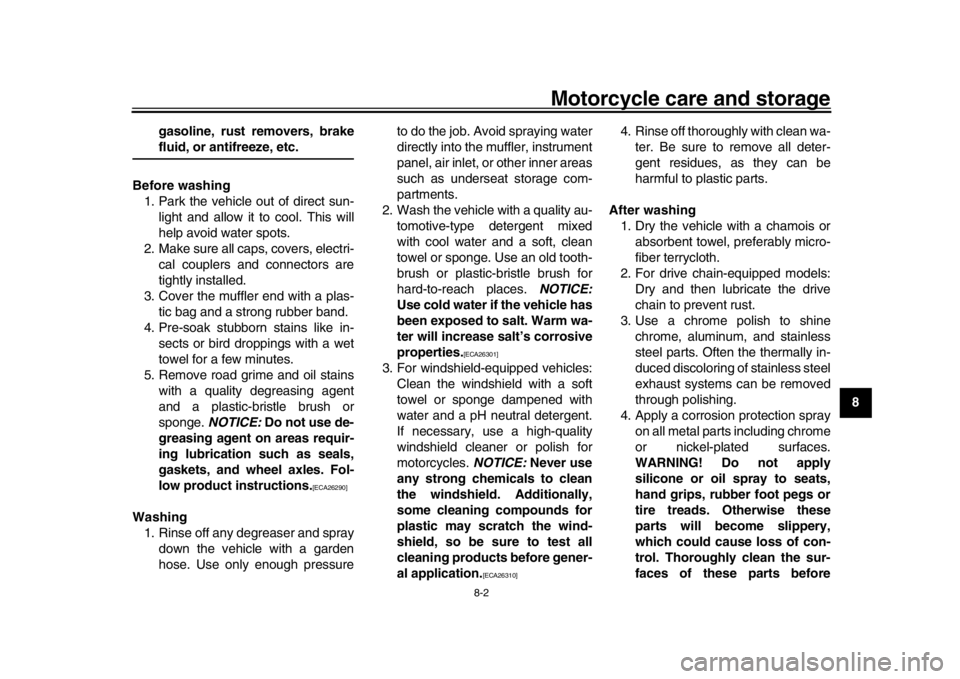
Motorcycle care and storage
8-2
1
2
3
4
5
6
789
10
11
12
gasoline, rust removers, brake
fluid, or antifreeze, etc.
Before washing 1. Park the vehicle out of direct sun- light and allow it to cool. This will
help avoid water spots.
2. Make sure all caps, covers, electri- cal couplers and connectors are
tightly installed.
3. Cover the muffler end with a plas- tic bag and a strong rubber band.
4. Pre-soak stubborn stains like in- sects or bird droppings with a wet
towel for a few minutes.
5. Remove road grime and oil stains with a quality degreasing agent
and a plastic-bristle brush or
sponge. NOTICE: Do not use de-
greasing agent on areas requir-
ing lubrication such as seals,
gaskets, and wheel axles. Fol-
low product instructions.
[ECA26290]
Washing 1. Rinse off any degreaser and spray down the vehicle with a garden
hose. Use only enough pressure to do the job. Avoid spraying water
directly into the muffler, instrument
panel, air inlet, or other inner areas
such as underseat storage com-
partments.
2. Wash the vehicle with a quality au- tomotive-type detergent mixed
with cool water and a soft, clean
towel or sponge. Use an old tooth-
brush or plastic-bristle brush for
hard-to-reach places. NOTICE:
Use cold water if the vehicle has
been exposed to salt. Warm wa-
ter will increase salt’s corrosive
properties.
[ECA26301]
3. For windshield-equipped vehicles: Clean the windshield with a soft
towel or sponge dampened with
water and a pH neutral detergent.
If necessary, use a high-quality
windshield cleaner or polish for
motorcycles. NOTICE: Never use
any strong chemicals to clean
the windshield. Additionally,
some cleaning compounds for
plastic may scratch the wind-
shield, so be sure to test all
cleaning products before gener-
al application.
[ECA26310]
4. Rinse off thoroughly with clean wa- ter. Be sure to remove all deter-
gent residues, as they can be
harmful to plastic parts.
After washing 1. Dry the vehicle with a chamois or absorbent towel, preferably micro-
fiber terrycloth.
2. For drive chain-equipped models: Dry and then lubricate the drive
chain to prevent rust.
3. Use a chrome polish to shine chrome, aluminum, and stainless
steel parts. Often the thermally in-
duced discoloring of stainless steel
exhaust systems can be removed
through polishing.
4. Apply a corrosion protection spray on all metal parts including chrome
or nickel-plated surfaces.
WARNING! Do not apply
silicone or oil spray to seats,
hand grips, rubber foot pegs or
tire treads. Otherwise these
parts will become slippery,
which could cause loss of con-
trol. Thoroughly clean the sur-
faces of these parts before
BX4-9-E2.book 2 ページ 2018年9月6日 木曜日 午後4時39分